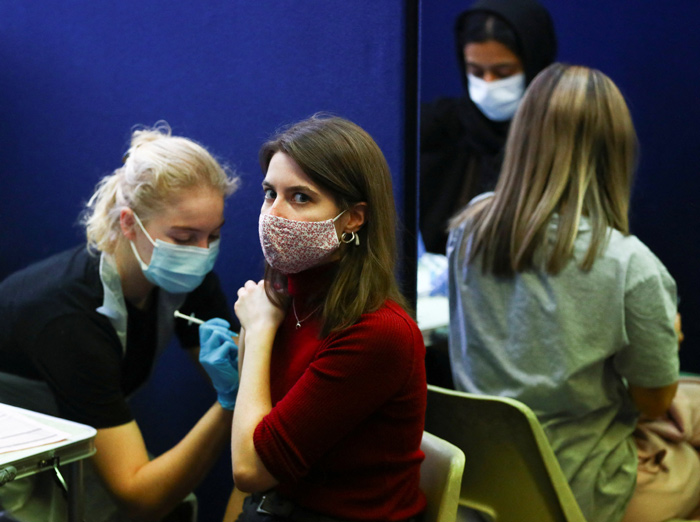日前,香港大学李嘉诚医学院的研究团队发现,相较于德尔塔变异株及原始病毒株,奥密克戎变异株在人体支气管组织内的复制速度大约快70倍。
 A woman reacts as she receives a dose of a COVID-19 vaccine at a coronavirus disease (COVID-19) vaccination centre in London, Britain, December 15, 2021. REUTERS/Hannah McKay
A woman reacts as she receives a dose of a COVID-19 vaccine at a coronavirus disease (COVID-19) vaccination centre in London, Britain, December 15, 2021. REUTERS/Hannah McKay
The Omicron Covid variant has been found to multiply about 70 times quicker than the original and Delta versions of coronavirus in tissue samples taken from the bronchus, the main tubes from the windpipe to the lungs, in laboratory experiments that could help explain its rapid transmission.
实验室在从支气管(连接气管和肺的主要管道)提取的组织样本中发现,奥密克戎新冠变种毒株的复制速度比原始新冠毒株和德尔塔毒株大约快70倍。这一实验有助于解释奥密克戎毒株的传播速度为什么这么快。
The study, by a team from the University of Hong Kong, also found that the new variant grew 10 times slower in lung tissue, which the authors said could be an indicator of lower disease severity.
香港大学的一个团队开展的这项研究还发现,新变异株在肺部组织内的繁殖速度会降低10倍,研究作者称,这可能意味着病情不会那么重。
Michael Chan Chi-wai, who led the work, said the result needed to be interpreted with caution because severe disease is determined not only by how quickly the virus replicates but also by a person’s immune response and, in particular, whether the immune system goes into overdrive, causing a so-called cytokine storm.
研究领头人陈志伟(音译)表示,应谨慎看待这一结果,因为是否发展为重症不仅取决于病毒复制的速度,还取决于人体的免疫反应,特别是免疫系统是否会因过激反应导致所谓的细胞因子风暴。
"It is also noted that by infecting many more people, a very infectious virus may cause more severe disease and death even though the virus itself may be less pathogenic,” he said. “Therefore, taken together with our recent studies showing that the Omicron variant can partially escape immunity from vaccines and past infection, the overall threat from the Omicron variant is likely to be very significant.”
他说:“研究还指出,即使病毒本身的致病性更低,但是传染性很强的病毒可能通过感染更多人而导致更严重的疾病。我们最近的研究显示,奥密克戎毒株可以绕过接种疫苗和感染后产生的部分免疫屏障,因此该毒株产生的整体威胁力可能非常大。”
Jeremy Kamil, an associate professor of microbiology and immunology at Louisiana State University Health Shreveport, pointed out that Delta, which turned out to be more pathogenic, showed a similar pattern of replicating more slowly in the lungs.
路易斯安那州立大学健康科学中心什里夫波特分校的微生物学和免疫学副教授杰里米·卡米尔指出,被证实致病性更高的德尔塔病毒也表现出在肺部复制速度变慢的相似模式。
"These authors found Omicron replicates fantastically well – even far better than either Delta or the original virus – in bronchial tissue,” Kamil said. “This could in some ways contribute to an advantage in spread/transmission between people.
卡米尔说:“研究作者发现,奥密克戎在支气管组织内复制速度极快,甚至比德尔塔或原始毒株快得多。这在某种程度上加剧了人与人之间的病毒传播。”
"Of course, a huge component of Omicron’s transmissibility in real life is going to be its potential to escape neutralising antibodies that protect against infection in the first place. It’s very likely spreading well even between vaccinated people, especially those who haven’t recently gotten a booster shot.”
“当然,现实生活中奥密克戎毒株的传播很大程度上依赖于它躲避人体抗体的潜力,而具有中和能力的抗体是防护的第一道屏障。该毒株甚至很可能在接种疫苗的人群当中也具有很强的传播力,尤其是那些最近没有打加强针的人群。”
The initial data, published online and not yet peer-reviewed, came from experiments using lung tissue samples taken from patients during surgery. By 24 hours, the Omicron variant had replicated about 70 times more than Delta and the original variant. Although the bronchus is not the upper respiratory system, scientists said this could lead to people shedding more virus and passing on infections more easily.
该研究的初期数据来自用手术过程中从患者体内获取的肺部组织样本做的实验,这些数据发布在网上,尚未经过同行评审。实验发现,奥密克戎变异株在24小时内的复制速度比德尔塔及原始毒株快了近70倍。尽管支气管不属于上呼吸道系统,但是科学家表示,这可能会导致人们释放更多病毒,从而更易传染他人。
The findings, together with other recent work showing Omicron infects cells more readily, add to an emerging picture that the variant may be intrinsically more transmissible in addition to evading existing immunity.
除了这些研究结果,前一阵也有其他研究表明奥密克戎毒株更易入侵细胞,综合起来可以看出,奥密克戎变异株除了可以躲避人体内现有的免疫屏障,而且本质上传播力更强。
英文来源:卫报
翻译&编辑:丹妮







